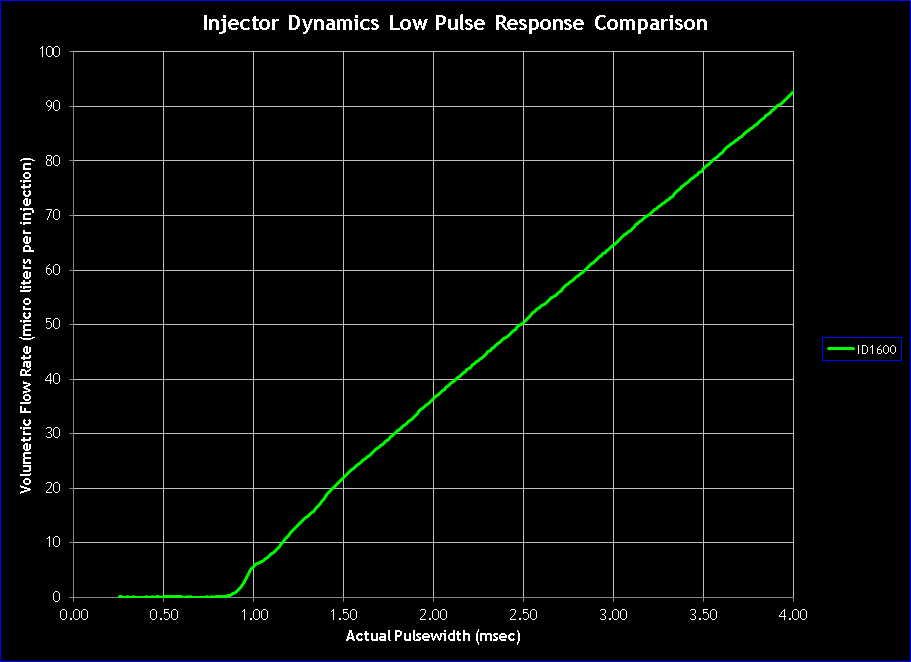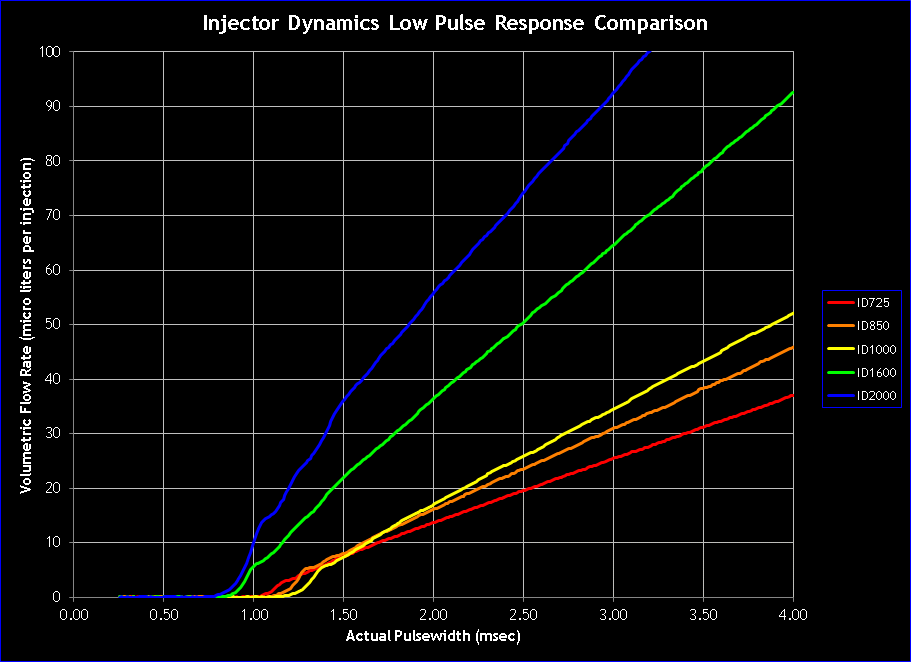Do you see references to the low pulse width performance of a fuel injector and wonder what it means?
Do you wonder how it relates to the real-world performance of the injector?
Are you just plain confused by statements like the one quoted below?
“This 1100cc fuel injector provides great trailing throttle response and minimum pulse widths resulting in a perfect cold start and idle”
While these kinds of senseless product descriptions make me snicker, giggle, and sometimes laugh uncontrollably, it’s really not a laughing matter. Statements like the one quoted above only serve to hold back an industry that has moved forward a great deal in the past few years.
And because of the negative effects of statements like that, I think its important to explain whats really happening “down low” and show how that information can be used to determine a fuel injectors ability, or inability to provide a solid consistent idle.
To start, let’s consider what we’re trying to accomplish. Our ultimate goal in any case where we care about idle quality would be a stable stoichiometric idle at a reasonably low rpm that is consistent across all operating conditions.
So what are we really asking of our fuel injector? We’re asking for the injector to deliver the relatively small volume of fuel that the engine uses at idle, and we’re asking it to do so regardless of variations in air temperature, pulsations in the MAP or MAF sensor output, or changes in barometric pressure, etc.
In other words, we need our injector to be predictable, well behaved, and we need its output to be proportional to the effective pulse width.
Notice that what we’re asking for is consistency in flow, with little or no concern for the pulse width required to deliver that flow.
The lambda sensor couldn’t care less if the pulse width is .5msec, or 3msec. It only cares how much fuel is being mixed with the incoming air.
For instance, if you have 5000cc/min injectors in your car that will accurately meter fuel the way down to .4msec, but they are still delivering enough fuel at that pulse wdith for a 10.5:1 air fuel ratio, your eyes will be bleeding. And they will be bleeding in spite of the fact that you have better low pulse width extension than any other injector on the market.
Conversely a set of 150cc/min injectors with absolutely awful response at low pulse widths could provide a rock solid stoichiometric idle because they are running somewhere in the range of 4 milliseconds.
Get my point? It is the flow we are concerned with, not the pulse width, and if we are fitting large injectors to a small engine it is the minimum amount of fuel that the injector can meter consistently that determines success or burning eyes.
So how do we determine the minimum amount of fuel that the injector can meter consistently?
As with most questions about fuel injectors, the answer lies in the flow vs pulse width curve.
The graph below shows the low pulse width portion of the flow vs pulse width curve for the Injector Dynamics ID1600 injector at 14volts, 3 bar differential fuel pressure.
The X Axis is the actual pulse width applied to the injector in milliseconds, and the Y axis is the volumetric flow, in microliters, for a single pulse. In simpler terms, the graph shows how much fuel will be injected into the cylinder for a given pulse width.

Lets start by defining the various portions of the curve.
Above 2 milliseconds the output closely approximates a straight line. This portion of the curve is referred to as the linear operating range, and it extends all the way to the upper non linear range which we will not be discussing in this article. Within the linear operating range, the ouput is perfectly predictable, and if our dead time compensation is correct, the output will be proportional to the effective pulse width.
Below 2 milliseconds is the lower non linear operating range which is made up of two sections separated by the distinct kink in the curve at 1 millisecond. This kink is referred to as the knee, and represents the pulse width required to fully open the valve. Below this pulse width, the valve is only opening partially with each cycle
Looking at the section between the knee at 1 millisecond, and the bottom of the linear range at 2 milliseconds, we can see that the output is not perfectly linear, or strictly proportional to the pulse width, but its response is relatively smooth and predictable. Because of this well behaved response, this is called the usable portion of the lower non linear operating range, and we can operate the injector in this range with good results.
On the other hand, the section below 1 millisecond is anything but well behaved. In addition to being only .15 milliseconds wide (Flow begins at .85 milliseconds) the flow doubles between .95msec to 1msec. That’s a doubling of flow with a change of only 50 millionths of a second! For obvious reasons, this is referred to as the non usable portion of the lower non linear operating range.
In case that’s not clear enough, consider what happens if an engined is tuned with an idle pulse width of 1 millisecond, right at the peak of the knee. It’s possible that minor pulsations from the MAP or MAF sensor will not vary the pulse width enough to cause problems, but what happens if the air temp increases due to heat soak from idling in traffic, a blast of boost, or changes in atmospheric conditions?
Your ECU will respond by decreasing the pulse width a small amount to account for the change in air density, but this small reduction will result in a major reduction in fuel flow, leaning the engine enough to make it stall.
Maybe it’s a change in air temperature, maybe its pulsations from other necessary sensors, or maybe its a simple matter of poor pulse width resolution of the ECU. Whatever the case, it will take very little pulse width variation to step off the edge of the cliff which will result in a drastic lean condition.
This “falling off the cliff” will always occur at the knee of the flow vs pulse width curve, regardless of the pulse width where it occurs. For that reason, defining this point as the minimum pulsewidth has little use in the real world because what we really need to know is the flow at that pulse width.
To help illustrate that point, the following chart includes the response of the entire line of Injector Dynamics fuel injectors.

Notice that the ID850, and the ID1000 have very slightly lower minimum flow values than the 1600, but that they occur at a much higher pulse widths. Also notice that the ID725 has a minimum flow value that is half that of the ID1600, yet it occurs at a higher pulse width. Does anyone reading this care about minimum pulse widths anymore?
Lets move on to practical use of this data.
Using just this sort of data, we have been able to determine the fuel usage of numerous engines at idle. How did we do that? Magic maybe? Nope…It’s as simple as recording the idle pulse width of a running vehicle, and then comparing that value to the curves above to determine idle fuel flow.
Having this ability has allowed us to steer customers in the right direction knowing nothing more than engine displacement. It has also allowed us to sort the good from the bad insuring that everything we release is a quality piece. By examining the flow vs pulse width curves of any injector we can answer important questions such as “Will this injector provide a stiochiometric idle on a 1.8 liter Honda engine?” “Or a 1000cc 4 cylinder motorcycle engine?”
We don’t need to wait for our pet tuner to try it out on his EVO, or his buddy’s WRX, we know before its ever installed in a running vehicle.
So am I bragging? Not really. Just trying to make a point. If I had to hand this in for a grade, my point, or more accurately my conclusion would be that it is no longer 1985. For that matter, it is no longer 2008.
This industry as a whole has moved forward at a rapid rate, and the ability to form logical conclusions from data, and to expect the availability of that data is commonplace.
Gone are the days of tuning poorly-behaved injectors with little data, and even less understanding of what makes them perform so poorly. Gone are the days of asking your injector supplier for pertinent data and getting a response ranging from a condescending attitude, to a blank stare.
So if you see an exception to this forward momentum, do the whole industry a favor and remind the offenders that its no longer 1985.
If this article left you with an unanswered question, please let us know and we will be happy to clarify it for you.
Thanks for reading.
Paul Yaw
Injector Dynamics
